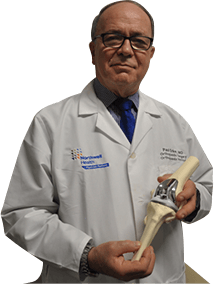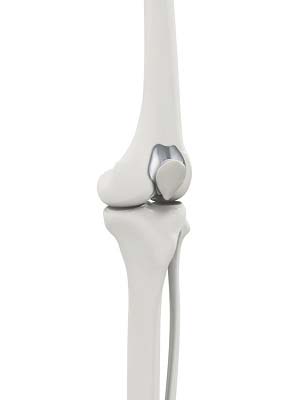Patellofemoral Knee Replacement
Specialist in Patellofemoral Knee Replacement in Great Neck and Woodbury, NY

Young and active individuals who have arthritis affecting only the patellofemoral compartment greatly benefit from patellofemoral knee replacement surgery, which preserves the knee parts not damaged by arthritis. Dr. Enker provides diagnosis and minimally-invasive patellofemoral knee replacement surgery in Great Neck and Woodbury, NY. Dr. Enker also provides the highest level of care during and after the surgery. Contact Dr. Enker’s office for an appointment today!

What is Patellofemoral Knee Replacement?
Traditionally, arthritis in only one compartment of the knee is treated by partial knee replacement surgery. Patellofemoral knee replacement is a minimally invasive surgical option performed in the patellofemoral compartment only, preserving the knee parts not damaged by arthritis as well as the stabilizing anterior and posterior cruciate ligaments (ACL and PCL).
The smaller implants used with a partial knee replacement surgery are customized to your anatomy based upon CT scans of your knee. A surgical robotic arm assists your surgeon with pre-operative planning and intraoperative component placement, positioning, and alignment. Patellofemoral knee arthroplasty surgery will not alter your ability to eventually move to a total knee replacement in the future should that become necessary.
Compartments of the Knee
The knee can be divided into three compartments: patellofemoral, the compartment in front of the knee between the kneecap and thighbone, the medial compartment, on the inside portion of the knee, and lateral compartment which is the area on the outside portion of the knee joint.
Indications of Patellofemoral Knee Replacement
Patellofemoral knee replacement surgery may be recommended by your surgeon if you have not obtained adequate relief with conservative treatment options. This less invasive bone and ligament preserving surgery are especially useful if you are young and active as the implant closely mimics the actual knee mechanics when compared to total knee surgery.
Patellofemoral Knee Replacement Procedure
Patellofemoral knee replacement surgery is performed on an outpatient basis as day surgery, under general anesthesia or spinal anesthesia with sedation. Your surgeon makes a small incision, about 3-4-inches long over your knee. With the assistance of the robotic arm, the patellofemoral compartment is prepared for the artificial components by removing the damaged part of the patella and trochlea, the groove at the end of the femur. The new artificial components are fixed in place with the use of bone cement.
The femoral component is made of polished metal and the patellar component looks like a plastic button that will glide smoothly in a groove located on the femoral component. With the new components in place, the knee is taken through a range of movements. Once your surgeon is satisfied with the results, the surgical instruments are removed and the incisions covered with a sterile dressing or biologic glue.
Postoperative Recovery after Patellofemoral Knee Replacement
You will be taken to the recovery room and monitored for any complications. You will be given pain medication to keep you comfortable at home. You will need someone to drive you home due to the drowsy effects of the anesthesia. Swelling is normal after knee surgery. Ice, compression, and elevation of the knee will help minimize swelling and pain.
You will be given specific instructions regarding the activity. Usually, there are a few activity restrictions. You will be referred to a rehabilitation program for exercise and strengthening. Eating a healthy diet and not smoking will promote healing.
Risks and Complications of Patellofemoral Knee Replacement
As with any major surgery, there are potential risks involved with patellofemoral knee replacement. The decision to proceed with the surgery is made because the advantages of surgery outweigh the potential disadvantages. Some of the possible complications include:
- Allergic reactions to medications
- Blood loss requiring transfusion with its low risk of disease transmission
- Heart attacks, strokes, kidney failure, pneumonia, bladder infections
- Complications from nerve blocks such as infection or nerve damage
- Infection
- Deep vein thrombosis
- Ligament injuries
- Injury to blood vessels or nerves
- Arthrofibrosis
- Wearing out of the prosthesis
- Dislocations and fractures
Risk factors that can negatively affect adequate healing after knee arthroscopy include:
- Poor nutrition
- Smoking
- Obesity
- Age (over 60)
- Alcoholism
- Chronic Illness
- Steroid Use
If you would like to have additional information on knee treatments or would like to learn more about patellofemoral knee replacement, please contact Dr. Enker, serving the communities of Great Neck and Woodbury, NY.
Related Topics:
- Bone Conserving Partial Knee Replacement
- Total Knee Replacement
- Minimally Invasive Knee Joint Replacement
- Robotic Unicondylar Knee Replacement
- Correction of a Failed Knee Replacement
- Correction of a Loose Knee Replacement
- Outpatient Unicondylar Knee Replacement
- Knee Arthroscopy
- Patellofemoral Knee Replacement
- Computer Navigation for Total Knee Replacement
- Revision Knee Replacement
- Robotic Assisted Knee Replacement
- Robotic Assisted Partial Knee Surgery
- Outpatient Total Knee Replacement
- Tricompartmental Knee Replacement
- Partial Medial Knee Replacement






